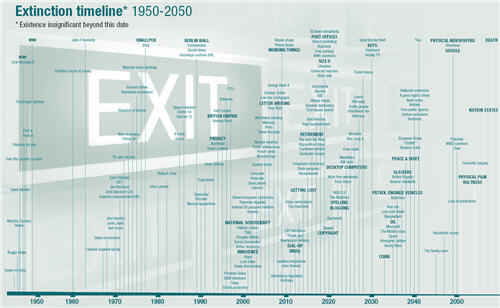There seems to be a trend for trend maps! Back in late December Nowandnext.com and Future Exploration Network released a map of major trends for 2007 and beyond, as below. My original blog post described some of the background to the trend map.

Click here for the full Trend Blend 2007+ map
The pdf version of the trend map has been downloaded over 20,000 times from the various sites at which it is hosted, with many times that number having seen the map. Along the way it has generated many, many comments – here is a small selection:
“The World’s Best Trend Map. Ever.” The Big Switch
“The mother of all trend maps” Cookthink
“A neat map of trends, words and made-up words in the form of a tube map. This is about as close to art as marketing strategy gets. Really usefu”’ Dead Insect
“I find these graphical depictions of trends fascinating. While no map can tell you everything, they are valuable for triggering ideas at a glance.” Free Rein
“The amazing Trend Map for 2007 and beyond” Madeforone.com
“If you’re interested in a global overview of next years trends, don’t miss out on Ross Dawson’s amazing Trendmap 2007” Information Architects
“Check out this off the hook trend map! Wow, cool.” The Caucus House
“I love visual stuff like this, and just spent half an hour redrawing all the coloured lines and connections after printing the map out on my b/w printer…” Yule Heibel
“I got shivers. A pattern to give us a way to talk about the future. I particularly appreciated the “river of conciousness” that runs through Ross Dawson’s map.” Nancy White
“Great piece of information architecture that shows how all the current trends out there come together and are shaped by the underlying motivators within society” Renaissance Chambara
“Visualisation of trends is amazing. It inspired me to think of the interaction of independent trends.” PSFK
“Perdu dans la jungle des buzz word, de la mondialisation, du hype, du Web 2.0 et du reste ? Heureusement Serial mapper est là et a trouvé pour vous cette magnifique carte “Trend Blend 2007+” Serial Mapper
“Las tendencias más bonitas. De todo lo que se está publicando sobre tendencias para el 2007, me quedo con este mapa del metro del 2007 de Ross Dawson.” The Mixer
“Un documento realmente interesante que con un diseño original y bastante creativo” The Orange Market
“Interessante visualização do conjunto, uma maneira mais inteligente de se entender e contextualizar o que vem por aí neste ano que está só começando.” Coolhunterbr
“Este tipo de trabajos para presentar la información están de moda, pero recomiendo su visualización porque ofrece una mirada comprensiva a las próximas mega-tendencias.” Javier Velilla
“Interessant sind vor allem wie sich Schnittstellen zwischen unterschiedlichen Trends ergeben.” AYRWeblog
(By the way, this is not only my work as some have assumed – Richard Watson conceived this project.)
A few days later after we released our map, Information Architects, seemingly inspired by our map, created a map of web trends, based on the Tokyo subway map.

Click here for the A4 pdf
Their map seems to have got even more attention, helped by blog posts from some of the A-list bloggers featured. They even scored an article in Sankei Shimbun, a Japanese business newspaper with readership of 2.8 million, as well as other media uptake in Germany and Italy.
In the course of exploring the impact of these trends maps, I came across GreatMap, a fabulous site that has hundreds of links to fabulous visual representations. It’s well worth a browse through its links to see some of the work being done in visualization.
We are clearly rapidly shifting to an increasingly visual culture. As our world becomes increasingly complex, particularly when we consider the extraordinary possibilities of the future, words and linear structures fail us. We respond to visual representations that help us to make connections, even if they’re more fun than serious, as for our trend map. As a result, we’ll continue to produce more visual representations of interesting trends and the future – coming up soon!




